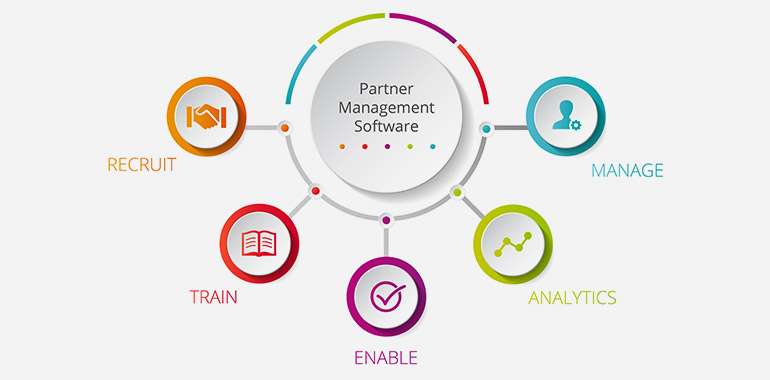Best Practices Articles

5 Things Your Partner Management Software Needs
Managing a vast number of channel partners in a distributed global environment is no small task. Organizations grapple with this every day, no matter big or small they are. However, by deploying partner management software and automating channel workflow management, any organization can greatly reduce the complexities of the channel environment, streamline channel management activities, and drive partner productivity and satisfaction. Today, we will explore the five core functions your partner management software needs to fulfil.
- Partner recruitment – Whether you are an established company or a fast-growing organization, you always need to recruit partners to build a healthy ecosystem of providers. To do so, you have to streamline your partner recruitment process from outreach to engagement to qualification and closure. You need partner management software to do this work for you in an efficient way.By leveraging your partner management software, you should be able to upload a prospective partner list into your partner records manager. From there, you should be able to run various types of integrated marketing campaigns—search, social, email, event, etc.—to engage with potential partners and then manage them through a recruitment funnel.Once you have recruited partners, your partner management software should allow you to automate the onboarding process whereby partners go through a 30-60-90-day stair-stepping process to become familiar with your contracts, products, and marketing and sales programs, and ultimately to learn to register deals and apply for incentives.
- Partner training – As a continuation of the onboarding process, your partner management software should be able to provide a solid foundation for helping partners learn about your products and services, understand how they can generate demand by leveraging various marketing tactics and, most importantly, learn which sales tools to use and how to close deals.Your partner management software should enable you to provide detailed learning plans for individual partner groups. Customization of learning plans by individual partner group prevents partners who sign up to sell one kind of product from being exposed to irrelevant content from other product areas. If you can’t customize content by partner group, the partner experience will quickly become very confusing and the engagement process will be unnecessarily complicated.In addition, your partner management software should be able to provide a clear certification path which partners can follow to find out exactly what they need to do to learn, grow and sell more products and solutions. The certification path needs to be logical, sequential and fully transparent, and it should provide partners with key points of contact so they can see how all the reps are performing. It should also allow you, the vendor, to easily track progress across multiple partners.
- Partner enablement – Sales enablement is a core capability that your partner management software needs to provide. It’s great to have a bunch of partners recruited, but if they are not selling at the speed and rate you want, then the effort is pretty much wasted. Therefore, once the partners are trained, the next most important step is to enable them with specific sales tools.Your partner management software should enable you to digitally warehouse multiple types of sales content in various format, such as HTML, HTML5 (for videos), PowerPoint, Word documents, PDF document and ZIP files. This digital content allows you to not only train your partner’s sales reps, but also equip them with sales collateral they can use during the sales process.In addition to enabling your partners with sales tools, you can also set up multi-tactic and multi-touch marketing campaigns that your partners can use for demand generation activities. Your partner management software should come with a fully equipped multi-tactic marketing engine that can be loaded up with your marketing content for all co-branding activities, and your partners should be able leverage that content via a simple point-and-click process.
- Incentives management – This is a very important part of overall partner relationship management. For you to manage partners effectively, your partner management software will need to have deep incentives management capabilities. Most organizations offer sales rewards as a core feature of their incentives programs for partner sales reps. Other organizations offer rebates for partner companies based on performance targets, and larger organizations will sometimes offer focused market development funds MDF/ co-op programs to incentivize partners.For any partner management software to work effectively for both your organization and partner organizations, the incentives process needs to flow in a seamlessly. These days, the world of incentives management can be very confusing. Often, the effectiveness of incentives tools is often minimal and incentives cannot be readily correlated with business impact. If you are looking for a way to effectively manage the performance of your partner base, make sure your partner management software platform has a complete set of tools to manage incentives programs easily and completely.Finally, make sure the incentives programs you are running are simple and easy to understand, and then run those programs over a reasonable period of time so partners have a chance to learn, engage and execute. Too often we see partner incentives programs that are too complex and too short in duration, and as a result partners don’t have sufficient time to adopt programs and drive results.
- Analytics – Managing the partner life cycle is hard, but with the right partner management software you can truly streamline core process steps and activities, improve predictability and set resource utilization at the right level. However, the key to achieving all of these objectives is having partner management software with the appropriate analytics.If you are considering procuring partner management software, please be certain that the platform has the analytical features that will enable you to figure out who the most productive partners are and the key factors in their success. You should also be able to use analytics to determine which partners have the most potential but are not currently succeeding, and identify the specific kinds of enablement, incentives and support they need to improve.Analytics can make or break your partner management software. Your partner system of records (PSOR) needs to be able to integrate data feeds from multiple subsystems and give you a unified view of performance and records. This is the holy grail of channel management, and it is fully achievable with the right partner management software.
I hope this article clearly shows how the right partner management software can enable you to manage your partner relationships in the most effective way. It starts with a focus on partner recruitment, training, enablement and management. After those elements are in place, analytics should enable you to understand who the most high-performing partners are and what you need to do to make all of your partners more successful. The great news is that all of this can be achieved today with partner management software.
If you want to learn more, please download our free guide to Unified Partner Management and then pursue the process in a focused way. Rome wasn’t built in a day, but when it was built, it ruled the world for hundreds of years. More power to you to do the same – with the right partner management software.
Best Practices Guidebook
 Definitive Guide to a Partner Ecosystem-First Sales Strategy
Definitive Guide to a Partner Ecosystem-First Sales StrategyDownload for FREE
 The Partner-Led Digital and AI Transformation Best Practices
The Partner-Led Digital and AI Transformation Best PracticesDownload for FREE
 Startup Talent Recruitment: Hiring Missionaries, Not Mercenaries
Startup Talent Recruitment: Hiring Missionaries, Not MercenariesDownload for FREE
 The Future of Partner Relationship Management with AI in Partnerships
The Future of Partner Relationship Management with AI in PartnershipsDownload for FREE
 Cybersecurity for the 99%: Strategies from the Frontline
Cybersecurity for the 99%: Strategies from the FrontlineDownload for FREE
 Mastering Partner Relationships: A Strategic Approach to Business Growth
Mastering Partner Relationships: A Strategic Approach to Business GrowthDownload for FREE
 The Smart Manufacturing Playbook: Industry 4.0 Transformation
The Smart Manufacturing Playbook: Industry 4.0 TransformationDownload for FREE
 Mastering Partner Relationship Management: Keys to SaaS Channel Success
Mastering Partner Relationship Management: Keys to SaaS Channel SuccessDownload for FREE
 Navigating the AI Revolution: Guide for Partners in the Microsoft Ecosystem
Navigating the AI Revolution: Guide for Partners in the Microsoft EcosystemDownload for FREE
 Mastering the Modern Buyers Journey: Sales Leader’s Guide to AI & Engagement
Mastering the Modern Buyers Journey: Sales Leader’s Guide to AI & EngagementDownload for FREE
 Hybrid Cloud and Edge AI Computing Impacting the Future of PRM
Hybrid Cloud and Edge AI Computing Impacting the Future of PRMDownload for FREE












